Soil Nutrient Management For Forages: Nitrogen
Introduction
Forage crops provide substantial income to many Montana farmers. They are also an integral part of livestock production systems, where winter feed can be the largest annual production cost on ranching operations (1). Improvements in forage production through improved soil fertility practices have the potential to increase income and reduce livestock production costs.
An important step towards soil fertility is nurturing soil health. In forage production this includes: allowing adequate plant recovery time, encouraging plant species diversity, and leaving cover and standing material to buffer changes in soil temperature and help store water. These may increase soil organic matter, aggregation, nutrient availability, plant resistance to stresses, and yield. Contact the National Resources Conservation Service (NRCS) for more information on management for soil health.
This bulletin focuses on using legumes or other sources of nitrogen (N) for established perennial forage stands. Newly seeded perennial stands and annual forage crops require slightly different N management and will be discussed briefly. Soil phosphorus (P), potassium (K), sulfur (S) and micronutrient management practices for forage crops are presented in EB0217. For additional information on plant nutrition, soil fertility, and N cycling, see MT4449-2 and MT4449-3. For information on species composition and grazing management
see EB0019 and EB0099. These and other resources mentioned in this bulletin are listed under “For more information” at the end of this bulletin.
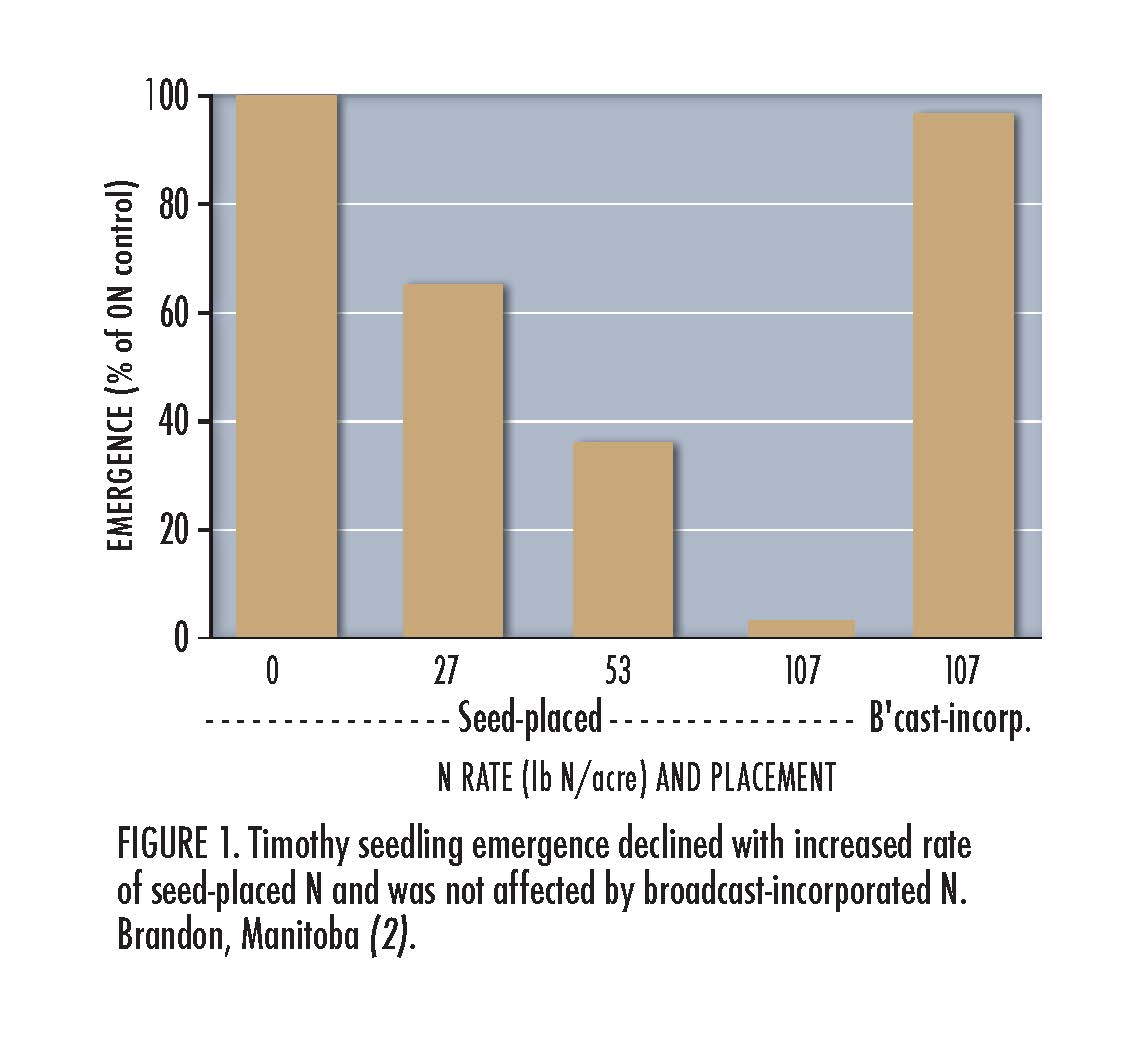
Nutrient Management
Of the 17 chemical elements that are essential for plant growth, N is the nutrient that most often limits grass growth. Nitrogen is very mobile in the soil and can become limiting in areas with high rainfall or irrigation, in coarse or shallow soils, and in soils with low organic matter. Nitrogen is lost by leaching, to the atmosphere, and by removal at harvest.
The key to N management for optimal forage yield and quality is to select the right fertilizer (or manure) source, rate, placement, and timing for your operation (4R Concept). These are usually interrelated; for example, the right rate, placement, and timing are very dependent on the source. In addition, selecting the right crop, the best management practices to maximize legume N fixation, and right crop rotation are also critical. Getting it ‘right’ not only increases your bottom line, it also protects soil, water, and air resources.
New or Interseeding
Nitrogen is not recommended when direct seeding into a stand of weeds or other undesired species because it stimulates growth of those species. These then provide too much competition for desired seedlings, especially of slow- establishing perennial species. Small amounts of N are only warranted if planting on sandy soils with low fertility or in late summer/early fall after a cereal grain crop, when soil available N has been depleted.
Under these circumstances, up to 60 lb N/acre may be beneficial in the first year (EB0161), but to avoid seedling damage, less than 10 to 15 lb N/acre should be applied with the seed (Figure 1). Surface broadcast
N application should be postponed until after seedlings have emerged and established secondary roots to minimize weed competition. If soil organic matter is greater than 3 percent, then decomposition of the organic matter may reduce the amount of N fertilizer required for 2 to 3 years.
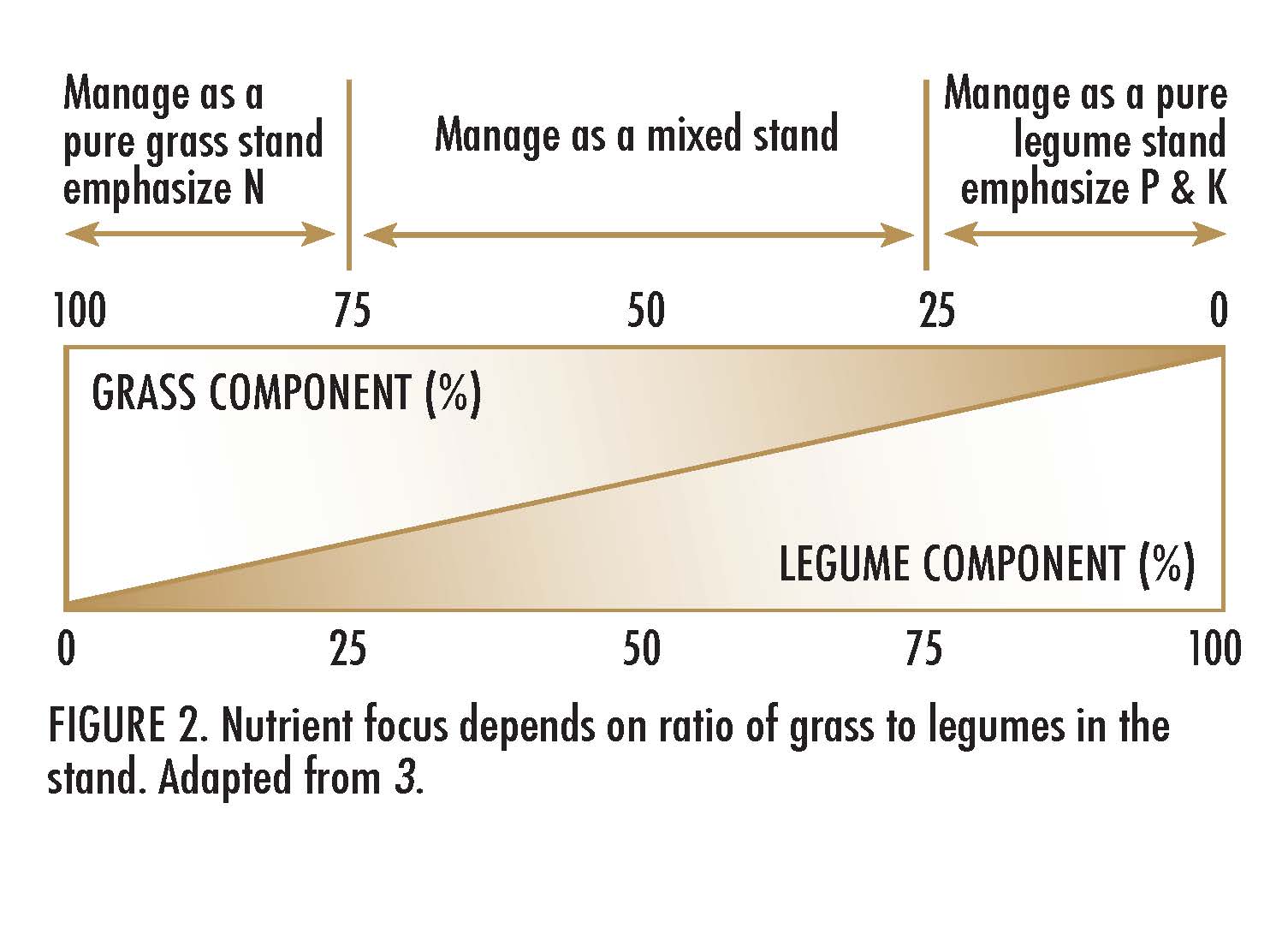
Established Stands
Maintaining forage stands and improving old stands with fertilizer is more effective than mechanical methods (aeration, harrowing and light disking) and less expensive than reseeding. However, fertilizing stands that have more undesirable than desirable species may increase production of the undesirable species. Weed control measures should be implemented near time of fertilization to maximize the return.
The proportion of grass to legumes in the field determines whether fertilization should focus on N or P and K (Figure 2). Fertilizing stands containing legumes with N will reduce the legume population and favor grass (Figure 3). Forage stands containing greater than 50 percent legume may respond little to applied N if soil conditions are suitable for N-fixation. Legumes require species-specific soil bacteria (rhizobia), which prefer soil pH higher than 6. They also require adequate P, K, S and micronutrients for healthy N-fixation (see EB0217). Yield increases and net returns from applied N have been found to be highest in fields with low percentages (less than 36 percent) of alfalfa and low levels of soil nitrate-N (5 lb N/acre; 5).
Source The most common sources of commercial fertilizer N are urea and urea ammonium nitrate (UAN). These are also available as ‘enhanced efficiency fertilizers’ designed to reduce N losses and increase N availability (see EB0188).
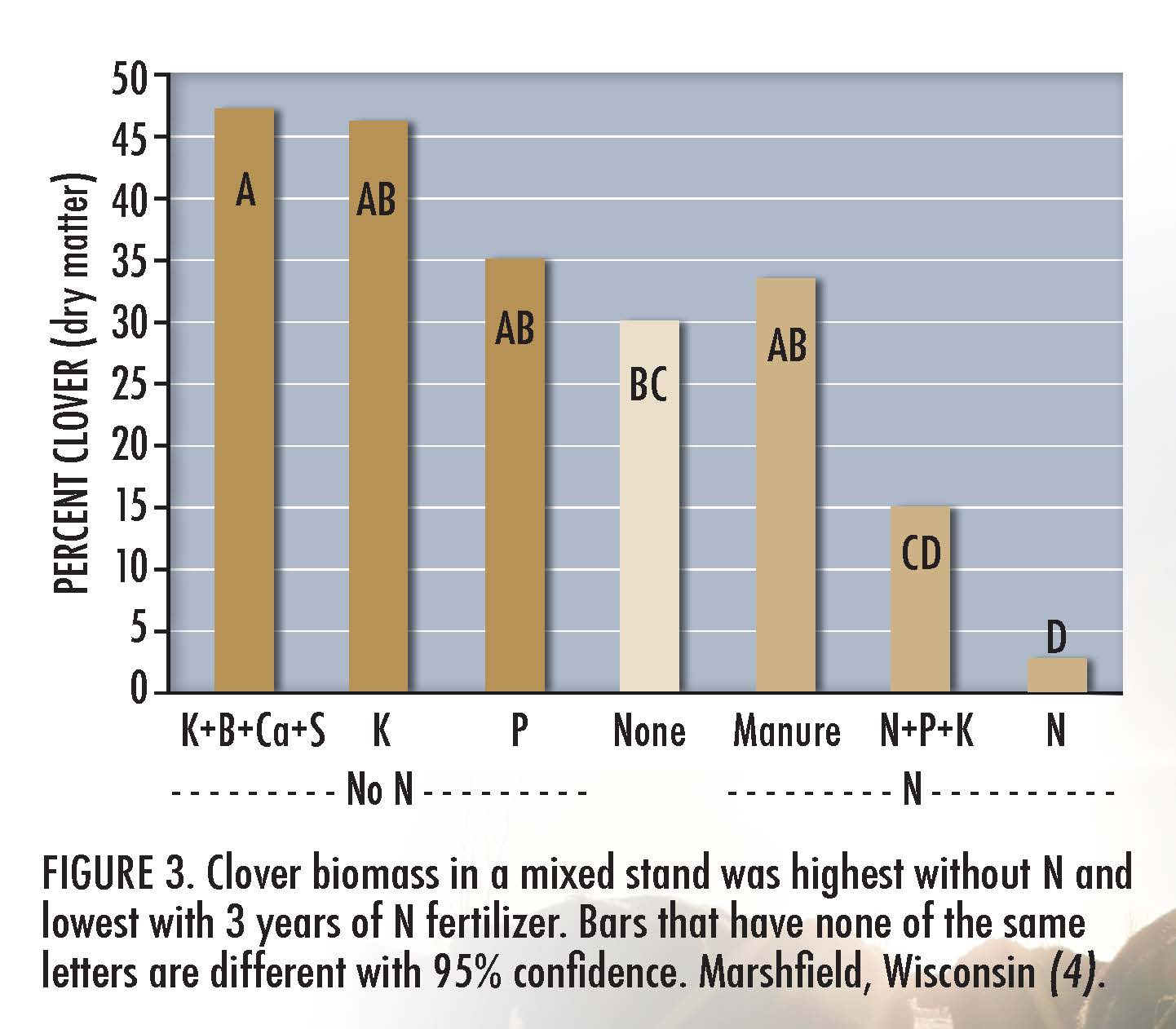
Unincorporated urea is more susceptible to volatilization loss than UAN (see EB0209). However, urea and ammonium-based fertilizers are less likely
to accumulate as toxic nitrate in forage than nitrate- containing fertilizers (5). The source should be selected based on cost per pound of available N, ease of application, potential germination issues if applied with the seed, and potential for high nitrate in plant tissue.
Nitrogen sources that need to decompose or break down in the soil to become plant available (manure or fertilizers that are polymer coated) will have a lag effect before the forage responds. They may provide N too late to stimulate early growth, or in areas with a short growing season. For example, in west-central
Alberta, spring-applied polymer-coated urea consistently produced less forage than urea broadcast on bromegrass pasture (6). However, slowly available N sources can extend benefits for season-long pasture or a late cutting.
If available, manure is a good source of N. However, fresh manure solids containing substantial straw (C:N greater than 40:1) may actually tie up N for a few weeks as they begin to decompose, and the amount of plant available N released may not peak until 2 to 3 years after application (see EB0200). Because manure nutrient content is highly variable, test the manure and soil for available N content to calculate application rates that meet crop needs (see 'Manure management resources' under 'For more information'). Be aware that manure can contain viable weed seeds or herbicide residues toxic to certain forage species.
Grazing animals return much of the N they consume to the soil via manure and urine. However, there is some N loss through cow weight gain and volatilization, and N can be redistributed from grazing areas to near corners, fences, and water. This can eventually lead to N deficiency in preferred grazing locations (7).
Interseeded legumes are an excellent source of N and improve forage quality. In a Wyoming study, irrigated grass-alfalfa mixes had higher yield than either pure grass with 134 lb N/acre or pure alfalfa without N, and similar crude protein to pure alfalfa (8). In southcentral Alberta, pure bromegrass dry matter yields required 90 lb N/acre annually to equal the yields of pure alfalfa fields without N (Figure 4). Forage stands with 33 to 66 percent alfalfa and no additional N yielded about the same as pure grass stands with 135 lb N/acre annually. In this three-year study, protein content, net margins, and hay produced per unit of energy input were greater from grass-alfalfa mixtures than from pure grass (9).
Interseeded legumes, as well as manure, contribute N that benefits yield and protein content throughout the growing season, rather than in a single flush (10, 11). For a summary of using legumes and manure as nutrient sources, see EB0200 and 'Manure management resources' under 'For more information'.
Rate
Base N rate on soil tests, the expected yield and the percentage of legume in the stand (Table 1). Soil tests from samples taken in the spring rather than fall usually better reflect N available to the crop in that growing season because of overwinter soil nitrate changes (13).
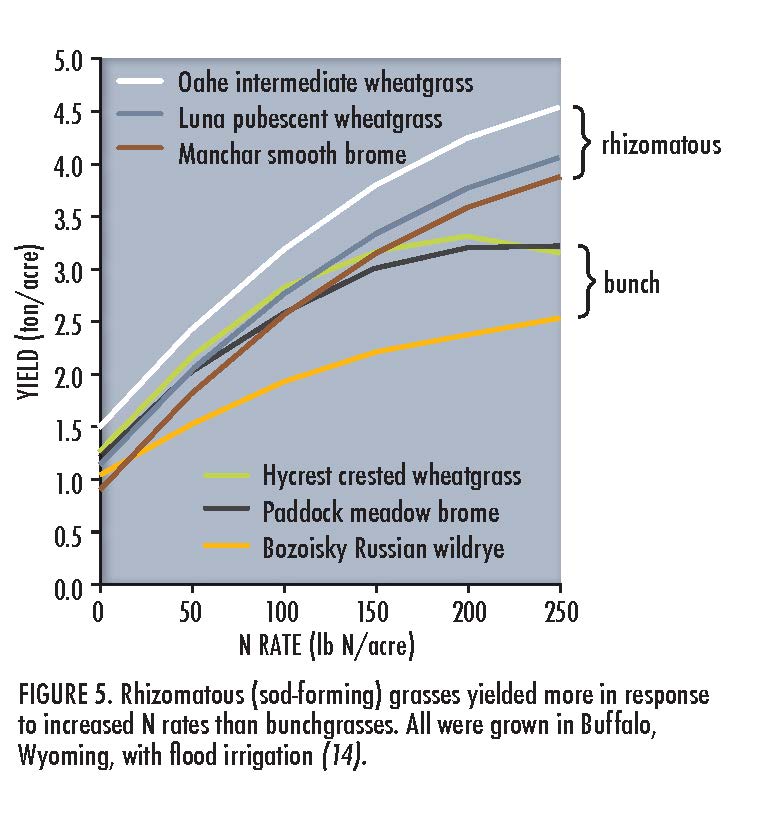
Generally, soil N in grass-dominated stands managed for hay is low because the stands remain undisturbed (untilled), thus releasing little N by organic matter decomposition. Adding N can increase yield of a vigorous grass stand if water is not limiting. Higher yielding grass species generally respond more to increasing N than lower yielding species adapted to low rainfall (Figure 5). However, as yield increases, grass digestibility decreases and protein content may decrease, unless N is added above generally economically viable rates (60 to 80 lb N/acre; 15). Fertilizing at high rates to increase grass protein increases the risks of high forage nitrate levels and downward movement of nitrate-N below the root zone.
Forage nitrate toxicity may occur at N rates well below those that maximize production (Figure 6). The tendency of grasses to accumulate nitrate varies with grass species and maturity (17). Of cereal forages tested in Montana and Wyoming, oat accumulated the most nitrate in high nitrate environments, spring wheat and triticale the least, and barley and spelt nitrate accumulation were very variety dependent. Nitrate concentrations decreased from flowering to soft dough stage in all species, suggesting delaying harvest may be worthwhile in high N environments, especially with nitrate-accumulating varieties (18). Check with your Range or Livestock Extension Specialist for species suitable for certain production systems, and talk to your Extension agent about conducting a quick test to determine if your forage has high nitrate.
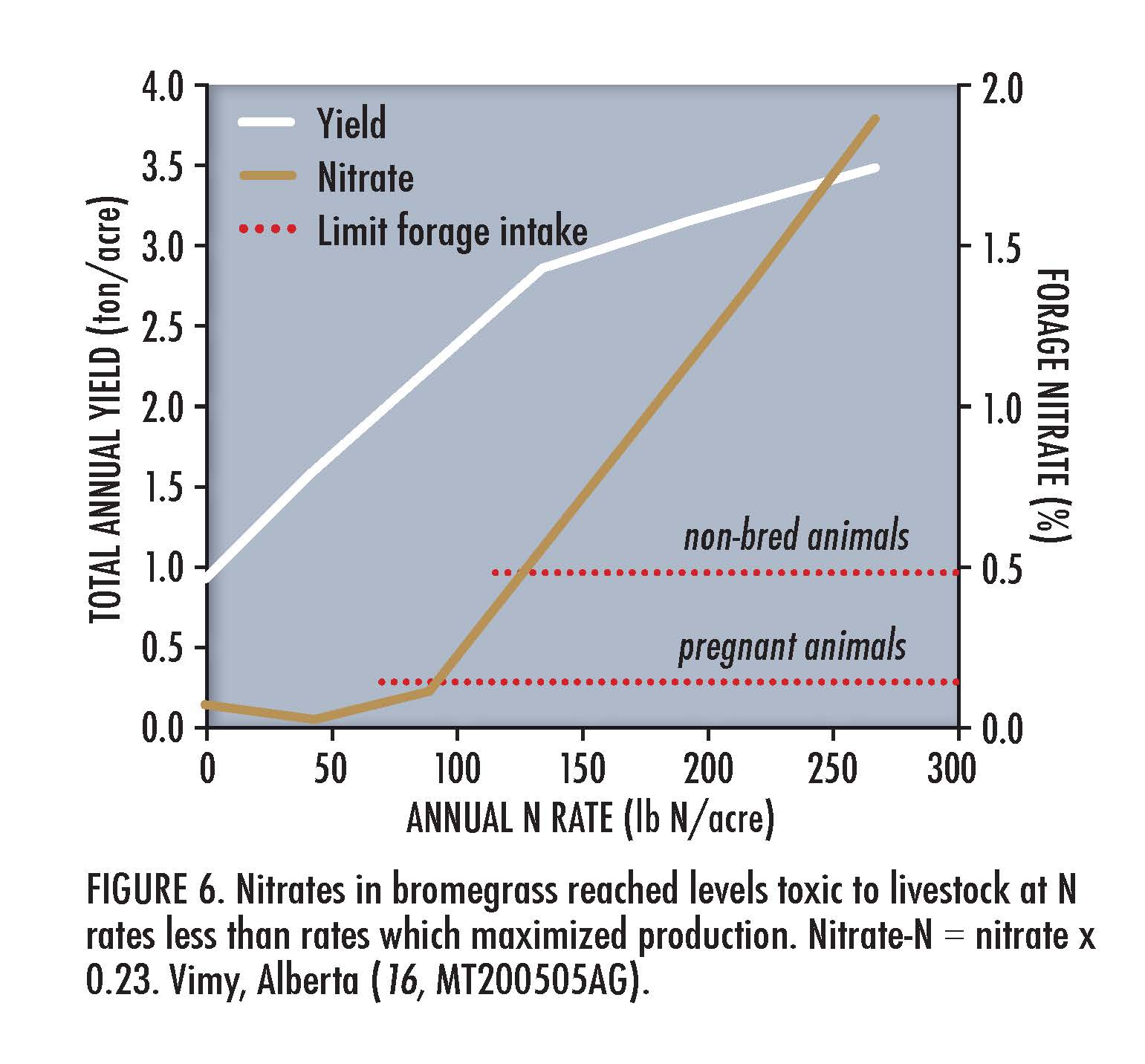
Visual N deficiency symptoms can be used to manage Nitrogen deficient plants have uniformly yellow or light green lower leaves (see MT4449-9). However, be cautious of pseudo-deficiencies, such as disease or herbicide damage that may look like N deficiency. Once plants are light green or yellow, potential yield has likely already been reduced. Therefore, it is better to rely on soil test recommendations, N removal rates, or tissue N concentrations (Table 2).
Special considerations:
Cereal forages – Growing cereal forages in rotation with perennial forages helps eliminate weeds and disease problems in the perennial rotation. Cereal forages can also relieve grazing pressure from perennial pastures or be baled for hay.
Preliminary field trials near Huntley and Froid, Montana, indicate dryland Willow Creek winter wheat requires 14 to 27 lb available N in the upper 2 feet of soil per ton of forage, while dryland barley requires 30 to 64 lb available N/ton of forage to maximize yield (20, 21, 22). These rates are based on fall soil tests. Because winter wheat establishes earlier and roots deeper than barley, its total N use is likely higher than the 14 to 27 lb N/ton measured, since it can scavenge deep soil N.
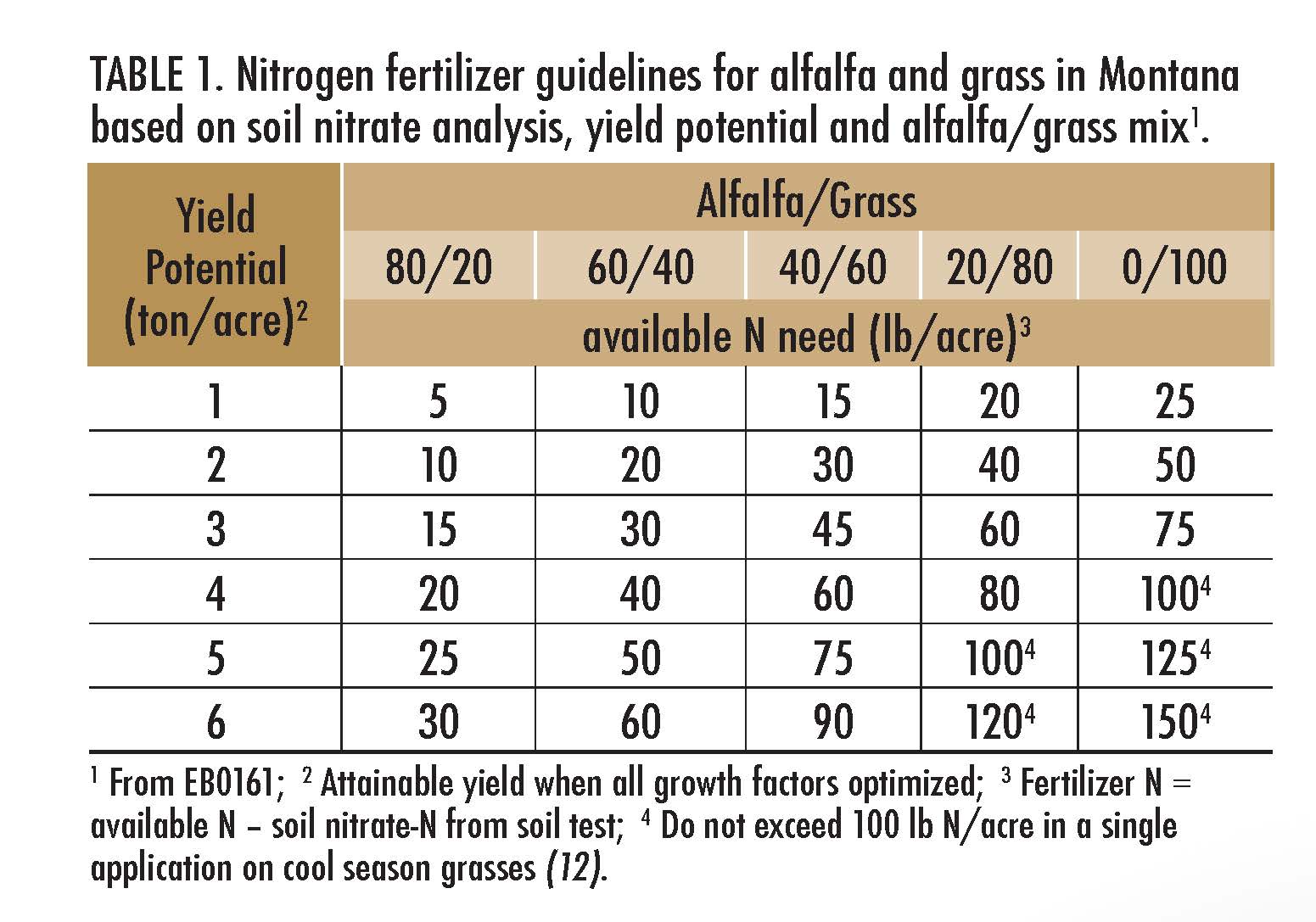
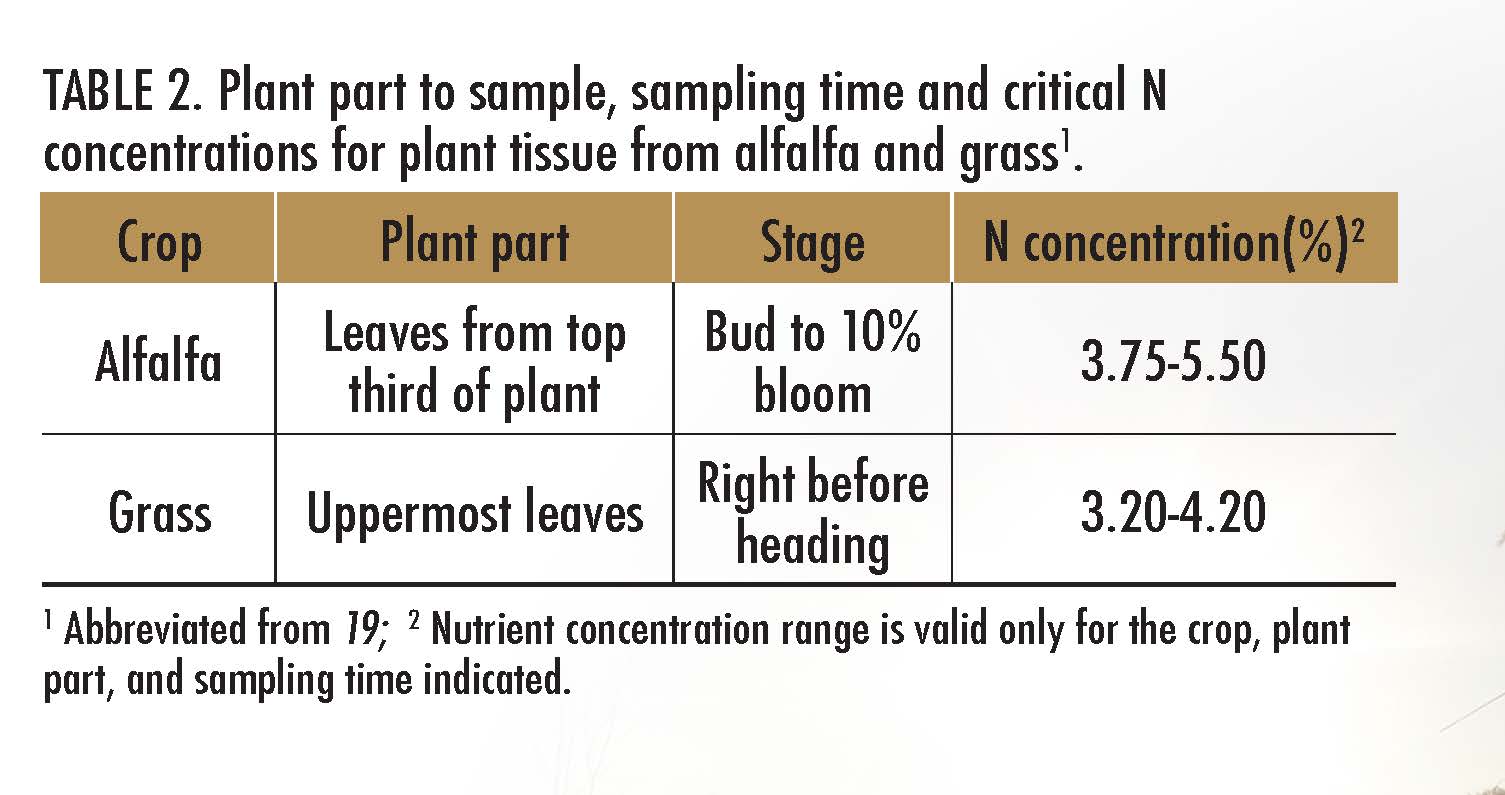
Mountain meadows – Based on several mountain meadow studies in Colorado, forage yield per pound of N is highest around fertilization with 40 to 60 lb N/acre. Higher N rates may reduce forage protein and digestibility and increase lodging (23). Meadows flooded during part of the growing season and dominated by a dense thatch of sod have lower
production response and recovery of fertilizer N than meadows on mineral soils. On these high organic soils, forage yields may decline for several years after N fertilization is discontinued. Once a fertilizer program is started, it is suggested to continue without interruption to maintain higher yields. Consider applying N on small test strips to evaluate a given field’s response to N fertilizer (24).
Native rangeland - Nitrogen fertilization of native rangelands provides a long-term residual effect (25). Although this may appear desirable, researchers from Montana, Colorado and Wyoming suggest caution because species composition may change to the detriment of the native plant community (15, 26, 27). Weed monitoring is very important on fertilized native range because there are few remedial options. Also, the costs of N fertilization or legume interseeding may be excessive.
Timing and Frequency Timing of N fertilization depends on the N source and soil and climatic conditions which influence how quickly N becomes available from soil organic matter. Sources that slowly release N over time (e.g. slow- or controlled-release fertilizer, or manure) should be applied well before N is needed.
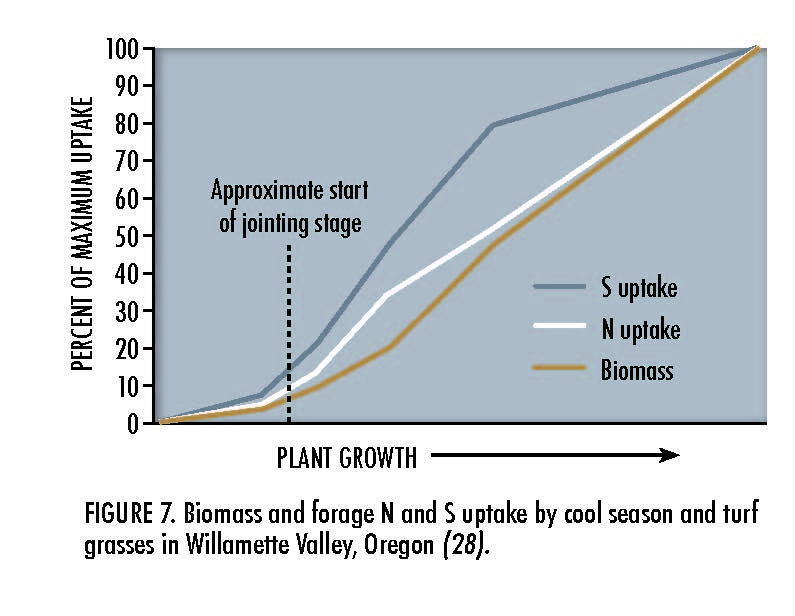
Sources that supply readily available N should be applied before the rapid increase in plant N uptake (Figure 7). This ensures adequate N for rapid growth and increases N recovery with fewer losses. Cool season grasses start rapid N uptake at jointing, therefore apply N in the spring shortly after green-up. If possible, time application so it can be incorporated with at least ½-inch of irrigation or rainfall in a single event to minimize volatilization loss and increase N recovery (Figure 8). Applying urea in fall under cool temperatures with ability to irrigate is an option. However, in soils with high leaching potential, such as coarse or shallow soils, fertilizer is better applied in the spring than fall to minimize overwinter loss (see MT201103AG). Also, fall application must be early enough that roots are still taking up N, but late enough that it does not stimulate leaf growth, which decreases winter hardiness.
Enhanced efficiency fertilizers delay the release of urea or conversion of urea to ammonium, which 'buys’ time for incorporation by rain or irrigation and, therefore, gives more flexibility in application timing. These fertilizers are discussed in the 'Source' section. See EB0208 and EB0209 for more information.
Split N applications increase N recovery by the crop and reduce potential water contamination. Although split N applications may not necessarily increase yield, they tend to distribute forage production over a longer portion of the growing season (Figure 9). This may increase protein in later cuttings and avoid elevated forage nitrate levels. On fields producing multiple cuttings, about half of the total required N is applied
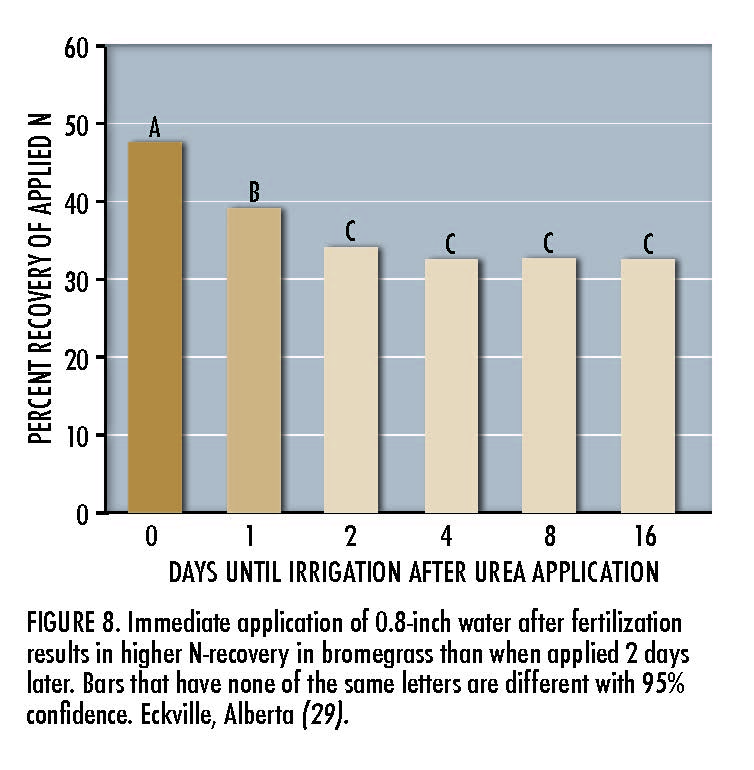
in early spring to take advantage of optimal growing conditions and the higher yield potential of cool season grasses; the remainder is applied after the first cutting or mid-grazing season, or split after a first and second cutting if a third cutting is anticipated. In years or areas
with low expected forage yields, split N applications may not be economical.
If N deficiency symptoms are observed, in-season N can be applied before stem elongation in grasses. After that point, it may be too late to improve yield. Plants that appear N deficient but do not respond to N may be S deficient, since adequate S is necessary for N uptake. Sulfur accumulates earlier and faster than N (Figure
7). In-season application of sulfate-S can correct S deficiency and is discussed in EB0217.
Placement Method Application method should maximize fertilizer uptake by the crop with minimal disturbance to the plants. Nitrogen fertilizer applied to thatch has high potential for N volatilization loss
(EB0208). Ammonia- and ammonium-based N fertilizer, including manure, should be immediately incorporated by rain or irrigation (Figure 8) or subsurface banded.
For example, a ½-inch rainfall within 3 hours of urea application on pasture can be sufficient to protect urea from volatilization, whereas a ½-inch of rainfall 2 days later may not (30).
If the fertilizer will be incorporated with water, then broadcast application is better than subsurface banding because it is less disruptive to the stand. However, under dry conditions subsurface banding may produce higher yields because there may be less volatilization loss and the N may dissolve sooner due to subsurface soil moisture (31). Bands should be at least 2 inches beneath the surface and the slit produced by banding or knifing well- closed to trap the ammonia produced by the urea band.
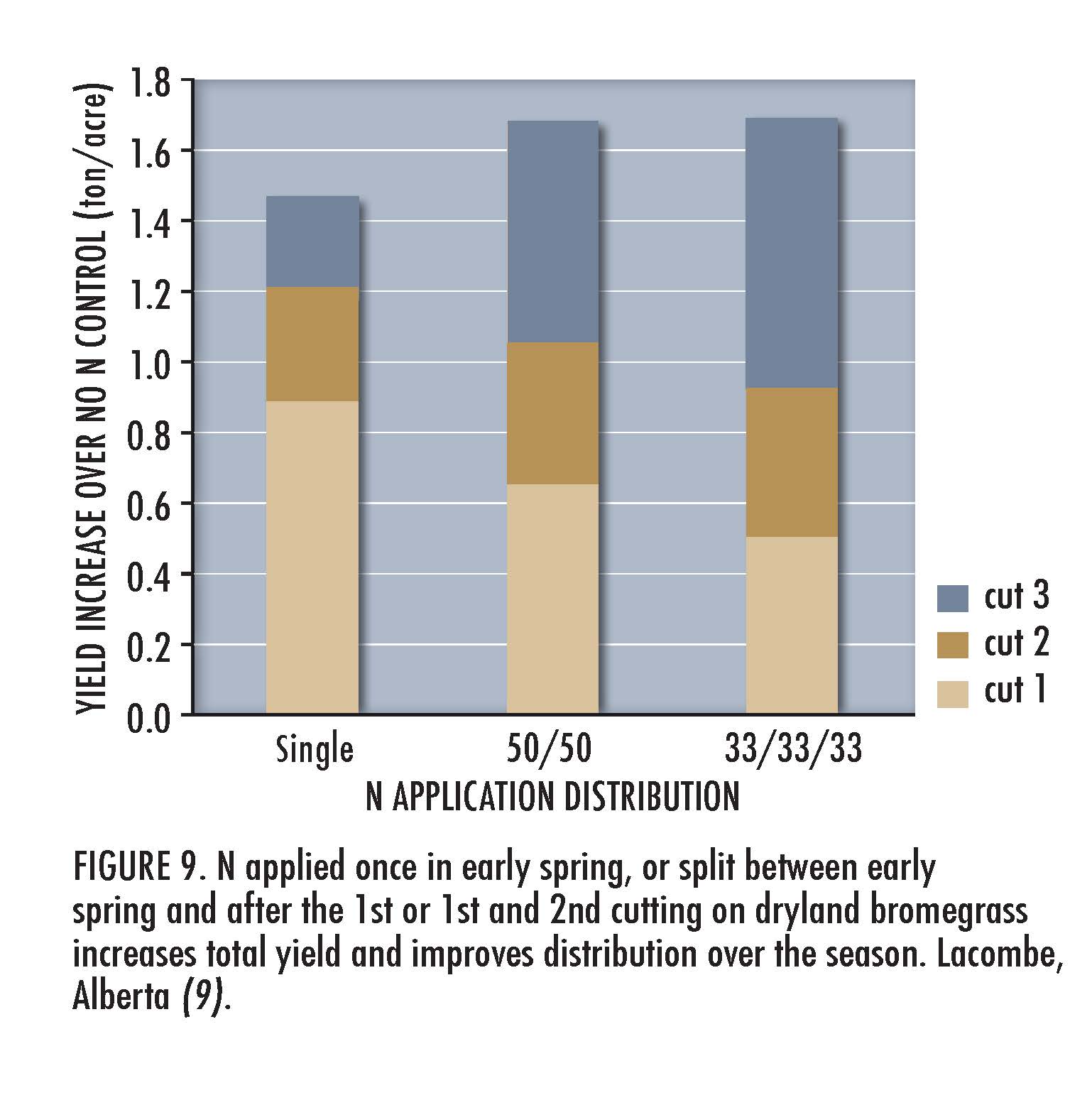
Practices that increase tisk of leaf burn:
- Greater than 30lb N/acre UAN or 45 lb N/acre of liquid urea (32)
- Herbicide, fungicide, and/or surfactant plus more than 20 lb N/acre UAN (33)
- Urea plus the urease inhibitor N-(n-butyl) thiophosphoris triamide (NBPT; 34)
- The addition of S to liquid N fertilizer (35)
- Application during high temperature conditions
- Application later in the season (35)
Foliar N is useful for in-season N adjustment if leaf burn is minimized (see text box 'Practices that increase the risk of leaf burn'). Because less than 16 percent of foliar N is taken up through the leaf (36), foliar N must be washed into the soil with at least ½-inch of water.
UAN is better applied as a surface band than a foliar spray to increase forage yield and protein (37).

Should I fertilize?
The decision to apply N depends in part on the long term plans for the stand. If a grass-legume field will be rotated to another crop within a year or two, consider applying N for a higher immediate yield. However, if the goal is to maximize time before reseeding with legumes, consider sacrificing some yield in the short term to concentrate on rejuvenating the legume portion of the stand (see EB0217).
Yield increases and net returns tend to be greater in fields with higher N deficiency, if all else is equal.
Use your typical yield estimate and a spring soil nitrate sample (Table 1). High yielding grass species, such as introduced rhizomatous grasses, tend to respond more to N than bunch grasses or native species (38). Grass varieties suited for low precipitation are generally less able to respond to high N rates than those suited to high precipitation (Figure 5).
Planting a legume in combination with grass to add soil N is usually more cost-effective than N fertilization for dryland pastures. However, the economic benefit
of N fertilization should be evaluated over several years. On dryland introduced rhizomatous grasses near Havre, Montana, single applications of 50 and 100 lb N/acre increased yields by 0.09 ton/acre (180 lb/acre) and 0.14 ton/acre (280 lb/acre), respectively, over the
unfertilized control. Four-year cumulative yield increases were 1.1 and 1.2 ton/acre for the 50 and 100 lb N/acre
applications, respectively (38).
A calculation of the necessary value of additional hay or animal unit month (AUM) produced to offset the urea fertilizer cost only (Figure 10) in the Havre study illustrates: 1) the 50 lb N/acre rate is more likely to provide a positive economic return than the 100 lb N/acre rate, 2) the economic benefit is greater when averaged over four years than just the first year, and 3)
fertilizing is generally a better option than buying hay or renting pasture, especially if it alleviates a chronic bottle neck in the production system. Urea could cost $800/ ton and a single 50 lb N/acre application would still be less expensive than buying hay (unless hay costs less than
$40/ton). Pasture rent could reach $23/AUM for each of 4 years before it costs more than the $800 invested in urea fertilizer to produce the equivalent additional AUMs.
The economic break-even point for fertilizing introduced bunch and native grasses averaged over 4 years (data not shown) were very similar to those of introduced rhizomatous grasses in the first year
(uppermost line in Figure 10). Fertilizing introduced bunch and native grasses may be an economical alternative to buying hay, but more likely more expensive than renting pasture. However, this does not take into account all costs associated with fertilizing, or providing hay or pasture, and, ultimately nutrients removed from a field need to be replaced to sustain forage production.
The N needed to optimize profit will vary for each production system depending on soil, other limiting factors like water and P, hay prices, and fertilizer N costs. As production intensity increases, so will the need for fertilizers to maintain production levels. Efficient fertilizer use is important in balancing productivity and the bottom line.
Summary
Nitrogen is the most common nutrient that needs to be added for production of forages containing a low percentage of legumes. However, N is generally not needed at seeding or during the first year of new
dryland or irrigated perennial stands. Nitrogen is not recommended in young alfalfa or sainfoin stands, or when interseeding into a stand dominated by undesired species. Readily available N sources, such as urea or UAN, should be applied shortly after green-up or as split applications
in a manner that minimizes volatilization loss. Slowly available N sources such as manure or slow- or controlled- release fertilizer will have a lag effect before the forage responds. They may provide nutrients too late in the spring to stimulate early growth, but can extend benefits for season-long pasture or a late cutting. Legumes may
be the most economical source of N. The proportion of legumes in a stand will influence N fertilizer rates.
Because fertilizer N can become tied up in the soil and plant material of perennial systems, the economic benefit of N fertilization should be evaluated over several years.
REFERENCES
- Nayigihugu, , A.D. Schleicher, D.W. Koch,
L.J. Held, J.W. Flake, and B.W. Hess. 2007. Beef cattle production, nutritional quality, and economics of windrowed forage vs. baled hay during winter. Agronomy Journal. 99:944-951.
- Alberta Ag and Rural Development. 2011. Perennial Forage Establishment in Alberta. Agdex 120/22-3.http://www1.agric.gov.ab.ca/$department/deptdocs. nsf/all/agdex9682
- Flore, N. 2003. Fertility Management in Saskatchewan Soil Conservation Association Conference. February 19-20. Saskatoon, Saskatchewan. pp. 78-87. http://ssca.ca/images/ pdf/2003_conference_pdf/Flore.pdf
- Schneider, N. 2009. Soil Fertility Influences Forage Species in http://winnebago.uwex. edu/files/2010/09/Fertility-and-Pasture-Species- Persistance.pdf
- Malhi, S.S., K.S. Gill, D.H. McCartney, and R. Malmgren. 2004. Fertilizer management of forage crops in the Canadian Great Plains. Recent Research Developments in Crop Science. 1:237-271.
- Karamanos, R.E. and C. Stevenson. 2013. Nitrogen fertilizer product and timing alternatives exist for forage production in the Peace region of Alberta. Canadian Journal of Plant Science. 93:151-160.
- Augustine, D.J., D.G. Milchunas, and J.D. 2013. Spatial redistribution of nitrogen by cattle in semiarid rangeland. Rangeland Ecology & Management. 66:56-62.
- Dhakal, D. and A. Islam. 2013. Legume grass mixtures reduce nitrogen requirements and production costs. University of Wyoming. pp. 30-33. www.uwyo.edu/uwexpstn/publications/reflections/ reflections-2013-web.pdf
- Malhi, S.S., P. Zentner, and K. Heier. 2002. Effectiveness of alfalfa in reducing fertilizer N input for optimum forage yield, protein concentration, returns and energy performance of bromegrass alfalfa mixtures. Nutrient Cycling in Agroecosystems. 62:219-227.
- Wagner, E. 1954. Legume nitrogen versus fertilizer nitrogen in protein production of forage. Agronomy Journal. 46:233-237.
- Ta, and M. Faris. 1987. Effects of alfalfa proportions and clipping frequencies on timothy-alfalfa mixtures. I. Competition and yield advantages. Agronomy Journal. 97:817-820.
- Brummer, J.E., J.G. Davis, and M.R. Booher. Fertilizing Cool Season Grasses and Grass/Legume Mixtures. Colorado State University Extension
No. 0.522. http://www.ext.colostate.edu/pubs/crops/00522.html
- Jones, C., C. Chen, J. Eckhoff, M. Greenwood, Lamb, A. Lenssen, K. McVay, P. Miller, B. Stougaard,
- Weeding, and M. Westcott. 2011. Changes in Soil Nitrate-N Levels from Late Summer to Early Spring in Montana. Fertilizer Fact No. 55. Montana State University Extension, Bozeman, Montana. http://
landresources.montana.edu/fertilizerfacts/index.html
- Horn, B. 2013. Hay study finds answer to what is most productive. University of Wyoming. pp. 33-36. www.uwyo.edu/uwexpstn/publications/ reflections/reflections-2013-web.pdf
- Brummer, J.E. Personal communication. Associate Department of Soil and Crop Sciences, Colorado State University, Fort Collins, Colorado.
- Penny, C., S.S. Malhi, and L. Kryzanowski. 1990. Effect of rate and source of N fertilizer on yield, quality and N recovery of bromegrass grown for hay. Fertilizer Research. 24:159-166.
- Smith, A.D. and L.E. Lutwick. 1975. Effects of N fertilizer on total-N and NO3-N content of six grass species. Canadian Journal of Plant Science. 55:573-
- Westcott, M., D. Wichman, and R. 2012. Evaluation of Nitrate Potential in Hay from Five Cereal Forage Species. Fertilizer Fact No. 56. Montana State University Extension, Bozeman, Montana.http://landresources.montana.edu/fertilizerfacts/ index.html
- Beegle, D. 2002. Soil Fertility Management for Forage Crops: Maintenance. Agronomy Facts 31-C. Penn State Extension. http://extension.psu.edu/plants/ crops/forages/soil-fertility/soil-fertility-management- for-forage-crops-maintenance
- McVay, A., A. Lenssen, and C. Jones. 2012. Cereal forage response to nitrogen fertilizer: Refining the Montana nitrogen rate guideline. Great Plains Soil
Fertility Conference. 14:161-166. Denver, Colorado.
- McVay, A. Unpublished data. Cropping System Extension Specialist. Southern Agricultural Experiment Station, Montana State University, Huntley, Montana.
- Lenssen, A. Unpublished data. Associate Department of Agronomy, Iowa State University, Ames, Iowa.
- Brummer, J.E. and N.D. Rill. 1999. Effects of Low Rates of Nitrogen Fertilizer on Yield and Quality of Mountain Meadow Colorado State University, Mountain Meadow Research Center Progress Report. February 5.
- Brummer, J.E. and J.G. Davis. 2012. Fertilizing Mountain Meadows. Colorado State University Extension 0.535. http://www.ext.colostate.edu/ pubs/crops/00535.html
- Power, F. 1972. Fate of fertilizer nitrogen applied to a Northern Great Plains rangeland ecosystem. Journal of Range Management. 25:367-371.
- Wichman, D. Personal communication. Superintendent and Research Scientist. Montana State University, Central Agricultural Research Center, Moccasin,
- Manske, L.L. 2010. Long-term Plant Species Shift Caused by Nitrogen Fertilization of Native North Dakota State University, Dickinson Research Extension Center. Summary Range Research Report DREC 10-3055. Dickinson, North Dakota.
- Hart, J.M., D.A. Horneck, D. Peek, and Young
III. 1989. Nitrogen and sulfur uptake for cool season forage and turf grass grown for seed. pp. 15-17.
In W.C. Young III (ed.) 1989 Seed Production Research. Dept. of Crop Sci., EXT/CrS 80. Oregon State University.
- Malhi, S.S. 1995. Influence of source, time and method of application, and simulated rainfall on recovery of nitrogen fertilizers applied to Nutrient Cycling in Agroecosystems. 41:1-10.
- Black, A.S., R.R. Sherlock, and P. Smith. 1987. Effect of timing of simulated rainfall on ammonia volatilization from urea, applied to soil of varying moisture-content. Journal of Soil Science. 38:679-687.
- Lamond, R.E. and J.L. 1983. Effects of knifed vs. broadcast fertilizer placement on yield and nutrient uptake by tall fescue. Soil Science Society of America Journal. 47:145-149.
- Brown, B. and L. Long. 1988. Response of ‘Ute’ to rate and source of foliar N. Proceedings, 39th Annual Far West Regional Fertilizer Conference. July 11-13. Bozeman, Montana. p. 111-116.
- Kells, J.J. 1996. Weed Management in Wheat. Wheat Michigan State University Extension Bulletin E2602. East Lansing, Michigan.
- Krogmeier, M.J., W. McCarty, and J.M. Bremner. 1989. Phytotoxicity of foliar-applied urea. Proceedings of the National Academy of Sciences, USA. 86:8189- 8191.
- Phillips, S.B. and G.L. Mullins. 2004. Foliar burn and wheat grain yield responses following topdress- applied nitrogen and sulfur fertilizers. Journal of Plant 27:921–930.
- Rawluk, C. G. Racz, and C. Grant. 2000. Uptake of foliar or soil application of 15N-labelled urea solution at anthesis and its affect on wheat grain yield and protein. Canadian Journal of Plant Science. 80:331-334.
- Kissel, D. 1988. Management of Urea North Central Regional Extension Publication 326. Kansas State University.
- Jacobsen, J., S. Lorbeer, H. Houlton, and G. Carlson. 1996. Nitrogen fertilization of dryland grasses in the Northern Great Plains. Journal of Range 49:340-345.
For more information
MSU Extension publications
These, and many others, can be found by title under 'Extension Publications' at http://landresources.montana.edu/soilfertility/, or by contacting MSU Extension Publications at (406) 994-3273 or online at http://store.msuextension.org.
Crop and Fertilizer Management Practices to Minimize Leaching. MT201103AG.
Dryland Pastures in Montana and Wyoming Species and Cultivars, Seeding Techniques and Grazing Management. EB0019.
Enhanced Efficiency Fertilizers. EB0188.
Factors Affecting Nitrogen Fertilizer Volatilization.
EB0208.
Fertilizer Guidelines for Montana Crops. EB0161.
Management to Minimize Nitrogen Fertilizer Volatilization. EB0209.
Nitrate Toxicity of Montana Forages. MT200505AG. (currently out of print)
Nitrogen Cycling, Testing and Fertilizer Recommendations.
MT4449-3.
Plant Nutrient Functions and Deficiency and Toxicity Symptoms. MT4449-9.
Plant Nutrition and Soil Fertility. MT4449-2.
Soil Nutrient Management for Forages: Phosphorus, Potasium, Sulfur and Micronutrients. EB0217.
Soil Nutrient Management on Organic Grain Farms in Montana. EB0200.
Species Selection, Seeding Techniques and Management of Irrigated Pastures in Montana and Wyoming. EB0099.
Manure management resources
Fertilizing Forages with Manure. 2008. Saskatchewan Ministry of Agriculture. http://www.agriculture.gov.sk.ca/Default.aspx?DN=feb4e9af-8270-440d-8739-5bd40cb6b344
Manure and Biosolids: Regulation and Management.
MT4449-13. http://landresources.montana.edu/nm/
Manure Nutrient Management. www.extension.org/pages/8647/manure-nutrient-management#.
USDA-NRCS. www.nrcs.usda.gov, search 'manure'
Using Manure as Fertilizer. EB0184. http://landresources.montana.edu/soilfertility/documents/PDF/pub/ManureFertEB0184.pdf
Other resources
Colorado Forage Guide. 2012. http://www.ext.colostate.edu/sam/forage-guide.pdf
University of Idaho Extension. Idaho Forage Web page http://www.extension.uidaho.edu/forage/
University of Idaho Extension. Managing Nutrients for Forage Crops Web page http://www.extension.uidaho.edu/nutrient/crop_nutrient/forages.html
ACKNOWLEDGEMENTS
We thank the following for their time and expertise in reviewing this bulletin:
- Joe Brummer, Associate Professor, Department of Soil and Crop Sciences, Colorado State University
- Paul Dixon, Agriculture and Natural Resource Specialist, Dixon Land Management, Sheridan, WY
- Marc King, Montana State University Extension Agent, Sweetgrass County, MT
- Dave Wichman, Superintendent and Research Scientist, Montana State University, Central Agricultural Research Center, Moccasin, MT
- MSU Extension Communications & Publications for design and layout
